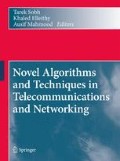Abstract
GSM Network Designs usually offers big challenges for achieving an efficient cost while respecting the complex combinatorial technical constraints. This networks have hundred or thousands BTS. They have their traffic grouped in hubs, then in BSC nodes to reach the MSC. Hubs must be elected within the BTS set and BSC nodes have to be geographically allocated in the available sites. Also, the number and model of these BSC impact in the overall cost while the distances affect the transmission costs. This paper presents a mathematical model for designing a GSM network from the BTS lower layer until the MSC layer.
Access this chapter
Tax calculation will be finalised at checkout
Purchases are for personal use only
Preview
Unable to display preview. Download preview PDF.
References
L. O. R. A. Ferreira, P. R. Pinheiro, A. B. de Aguiar, and E. M. Macambira. Design of cellular network using lagrangean relaxation algorithm. In Proceedings of Inter- national Conference on Computer, Communication and Control Technologies and The 9th International Conference on Information Systems Analysis and Synthesis. Orlando, 2003.
A. B. de Aguiar and P. R. Pinheiro. A Model for GSM Mobile Network Design, chapter Innovative Algorithms and Techniques in Automation, Industrial Eletronics and Telecomunications, pages 365–368. Springer Netherlands, Dordrecht, September 2007.
A. B. de Aguiar, P. R. Pinheiro, and M. M. Rodrigues. Um modelo para telefonia celular. In Anais do XXXV Simpósio Brasileiro de Pesquisa Operacional. Instituto Doris Aragon, Rio de Janeiro, 2003.
M. L. Fisher. The lagrangian relaxation method for solving integer programming problems. Manage. Sci., 50(12 Supplement):1861–1871, 2004.
ILOG. ILOG CPLEX 10.0 User’s Manual, January 2006.
P. Kubat and J. M. Smith. A multi-period network design problem for cellular telecommunication systems. European Journal of Operational Research, 134(2):439–456, October 2001.
P. Kubat, J. M. Smith, and C. Yum. Design of cellular networks with diversity and capacity constraints. IEEE Transactions on Reliability, 49(2):165–175, June 2000.
A. A. Rigolon, P. R. Pinheiro, M. M. Rodrigues, E. M. Macambira, and L. O. R. A. Ferreira. Relaxação lagrangeana com método de subgradiente aplicada no projeto de uma rede de telefonia móvel. In XXXVII Simpósio Brasileiro de Pesquisa Operacional (SBPO). Sociedade Brasileira de Pesquisa Operacional - Sobrapo, Sociedade Brasileira de Pesquisa Operacional - Sobrapo, September 2005.
L. A. Wolsey. Integer Programming. John Wiley & Sons, 1998.
N. V. Nepomuceno, P. R. Pinheiro, A. L. V. Coelho. Tackling the Container Loading Problem: A Hybrid Approach Based on Integer Linear Programming and Genetic Algorithms. Lecture Notes in Computer Science, v. 4446, p. 154–165, 2007.
N. V. Nepomuceno, P. R. Pinheiro, A. L. V. Coelho. A Hybrid Optimization Framework for Cutting and Packing Problems: Case Study on Constrained 2D Non-guillotine Cutting. In: C. Cotta and J. van Hemert. (Org.). Recent Advances in Evolutionary Computation for Combinatorial Optimization. Berlin / Heidelberg: Springer-Verlag, 2008, v. 153, p. 87–99.
Acknowledgment
Alexei gratefully acknowledges Capes for its financial supports through a M.Sc. scholarship.
Author information
Authors and Affiliations
Editor information
Editors and Affiliations
Rights and permissions
Copyright information
© 2010 Springer Science+Business Media B.V.
About this paper
Cite this paper
de Aguiar, A.B., Pinheiro, P.R., de Neto, Á.M.S., Pinheiro, R.F., Cunha, R.P.P. (2010). A Multi-layer GSM Network Design Model. In: Sobh, T., Elleithy, K., Mahmood, A. (eds) Novel Algorithms and Techniques in Telecommunications and Networking. Springer, Dordrecht. https://doi.org/10.1007/978-90-481-3662-9_78
Download citation
DOI: https://doi.org/10.1007/978-90-481-3662-9_78
Published:
Publisher Name: Springer, Dordrecht
Print ISBN: 978-90-481-3661-2
Online ISBN: 978-90-481-3662-9
eBook Packages: EngineeringEngineering (R0)

